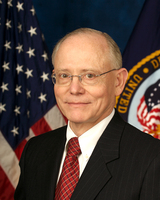Secretary of Veterans Affairs under George W Bush
James Peake was United States Secretary of Veterans Affairs from 2007 to 2009. In 2004, he retired from a 42-year United States Army career. He also served as the 40th Surgeon General of the United States Army. Peake received his Bachelor of Science degree from U.S. Military Academy at West Point in 1966 and was commissioned a second lieutenant in the U.S. Army Infantry. He served in Vietnam with the 101st Airborne Division where he was awarded the Silver Star, a Bronze Star with "V" device and the Purple Heart with oak leaf cluster. Following his service in Vietnam, he attended Cornell University’s Weill Cornell Medical College, and was awarded a medical doctorate in 1972. He is also a graduate of the United States Army War College, in 1988. He retired from the Army in 2004, as a Lieutenant General. Dr. Peake served for four years as the United States Army Surgeon General. He also served as commander of several Army medical units. Previous key assignments include Commander, U.S. Army Medical Department Center and School and Installation Commander, Fort Sam Houston, Texas; Deputy Commander, U.S. Army Medical Command, Fort Sam Houston, Texas; Commanding General, Madigan Army Medical Center/Northwest Health Service Support Activity, Tacoma, Washington; Commanding General, 44th Medical Brigade/Corps Surgeon, XVIII Airborne Corps, Fort Bragg, North Carolina; Deputy Director, Professional Services/Chief, Consultant, Office of the Surgeon General, Falls Church, Virginia; Commander, 18th Medical Command and 121st Evacuation Hospital/Command Surgeon, Seoul, Korea; Deputy Commander for Clinical Services, Tripler Army Medical Center, Honolulu, Hawaii; Assistant Chief, Cardiothoracic Surgery, Brooke Army Medical Center, Fort Sam Houston, Texas; Staff General Surgeon/Chief, General Surgery Clinic, DeWitt Army Hospital, Fort Belvoir, Va.; and General Surgery Resident, Brooke Army Medical Center, Fort Sam Houston, Texas. After retiring from the Army, Dr. Peake served as Executive Vice President and Chief Operating Officer of Project Hope, a non-profit international health foundation operating in more than 30 countries. While at Project HOPE he helped to orchestrate the use of civilian volunteers aboard the Navy Hospital Ship Mercy as it responded to the Tsunami disaster in Indonesia and also as part of the Hurricane Katrina response aboard the Hospital Ship Comfort.
